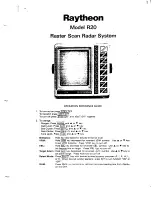
Rev: November 20 2006
10
on and press the key or the dot paddle. You should here the sidetone.
Adjust the level by P4. Go ahead with section 4.
Baugruppe 4 ZF Verstärker / BFO
The FET amplifier T3 together with the transformer Dr4/C16 acts as coupler
to couple the impedance of the Ladderfilter to the selectiv amplifier T4/T5.
As far as we know, the design of the following cascaded IF Amplifier by
Peter, DK1HE is absolutely unique and new. You will enjoy it´s features after
your BCR is ready built.
Transistors T4/T5 are in terms of DC serial cascaded and use half of the
Voltage (4V) each. The commen collector current is adjusted by R14 to
about 3,5mA which is significant low compared
to two seperate driven singel Amplifier stages.
By T6 easily the current through the complete
chain can be varied and by this, the Gain factor
of T4/T5 that means the gain of the IF amplifier
can be regulated. In Terms of RF the amplifier
works conventional. C20/C21 decouple both
stages. T4 does not work with the low input
impedance T5 but its working resitance is the
resonate circuit L4/C9 which gives us much
higher gain per stage.
Output of T5 is working with the resonate
circuit L5/C24. By damping resistors R13/R18
the total unregulated gain is adjusted to about
70 dB.
The IF signal is inductiv coupled by L5 to the
following product detector T7 and diode D10.
D10 has to do 2 jobs: 1. it is used as AM
Detector if BCR is used in AM with BFO switched
off and 2. it generates the AGC Voltage directle
from the IF without an extra amplifier. The AGC
curve can be adjusted by P5.
D10 generates a negative voltage which is
proportional to to the IF Voltage. The neagtiv
voltage reduces the base current of T6 in
conjunction with the fieldstrength of the
received signal, so the total collector currend
and total gain decrease. 0dBm (220mV) at the antenna can be kept by the
AGC without any distortions. Because D10 is used with a negativ Voltage,
eben very small signals can start the AGC. By its negativ temperatur
coefficient D10 compensates the tempereratur sensible base-emitter
junction of T6. The AGC works stable over a wide temperature range.
CW and SSB denodulation is done by the MOS tetrode T7. To keep the
number of parts low, it is designed as a self oscillating mixer. The BFO
Quatz is oscillating with an offset of 500-900 Hz. Behind the Lowpas R24/
C35 there is an AF signal, which can be handled by the AF amplifier.
ZF-Vorverst.
ZF-Verstärker
ZF-Verst.-Regelung
+8V
AGC-Spannung
0,2-1V
+8V
T3
T4
T5
T6
D10
P5
C11
C14
C15
C16
C17
C18
R8
R9
R10
R11
R12
R13
R14
R15
R16
R17
R18
zu CPU
A
A
C19
C20
C21
C22
C23
C24
C25
C26
C27
C28
L4
L5
1
2
3
4
1
2
3
4
Dr3- 100uH
Dr4- 33uH
Dr5 - 100uH
0,47uF
50k
1N4148
47nF
47nF
150p
18Wdg
6Wdg
6,8nF
470k
270R
BC550
BF199
BF199
47nF
47nF
8k2
12k
47nF
entfällt
150p
3k3
12k
33pF
47nF
47nF
2Wdg
18Wdg
3k9
270R
1k
150pF
47nF
47nF
2k2
BF244A
Baugruppe ZF-Verstärker / BFO
C92
22p
BFO
AM Signal
Содержание Blue Cool Radio
Страница 24: ...Rev November 20 2006 24 ...
Страница 27: ...Rev Nobember 20 2006 27 DDS Unit ...
Страница 28: ...Rev November 20 2006 28 BCR Mainboard Part side complete ...
Страница 29: ...Rev Nobember 20 2006 29 BCR mainboard Solderside SMT Parts ...
Страница 30: ...Rev November 20 2006 30 ...
Страница 32: ...Rev November 20 2006 32 ...
Страница 34: ...Rev November 20 2006 34 ...
Страница 36: ...Rev November 20 2006 36 ...
Страница 38: ...Rev November 20 2006 38 ...
Страница 40: ...Rev November 20 2006 40 ...
Страница 42: ...Rev November 20 2006 42 ...
Страница 44: ...Rev November 20 2006 44 ...











































